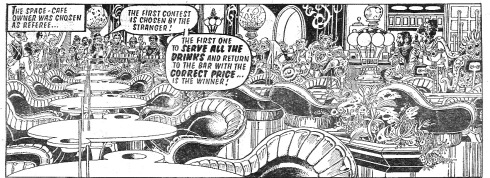PROG: 161 – DROIDS ARE DISPOSABLE
Script: Gary Rice
Art: Brett Ewins
Letters: Tony Jacob
Plot: The spaceship Freya has crashed hundreds of miles from the nearest base and the robot EZ1 combs the wreckage to see if it is the only survivor. Finally it finds the badly injured Lieutenant Nash, the sole human left alive, and, picking up his broken body in its arms, EZ1 begins the long trek to get Nash to safety. Nash is disgusted at being aided by a robot, making clear that he hates machines like EZ1; but, as EZ1 fends off predators and fierce weather conditions to protect the Lieutenant, gradually he comes to respect his metallic guardian. WIth its power supplies nearly depleted, EZ1 finally arrives at the base. It’s circuits breakdown as it enters the safe-haven having successfully saved the life of Nash.
Ending: Lieutenant Nash comes to in the camp’s hospital and enquires into how EZ1 is doing after their arduous trek. After being told he was ‘put to good use‘ the Lieutenant looks down at his first meal and see’s EZ1’s serial number stamped on the plate. EZ1 has been scrapped because ‘droids are disposable‘.
Thoughts: Gary Rice’s second Robo-Tale is a nicely executed story which returns to a theme of early Future Shocks – that humans are utter bastards – in a tale that echo’s much of the humanism Sci-Fi of the 1970s. The story of Nash and EZ1 bonding through survival is not so much traditional buddy movie material, as Nash is incapacitated throughout, as A Boy and His Dog or Silent Running. It’s a well executed tale with the antagonism to EZ1, despite his heroics, foreshadowed by Nash’s own initial reactions. The script throws in a fight with a winged beast to keep the tension high as well as reinforce why Nash learns the lesson the people at the base then neglect. In terms of story the use of a robot talking to itself is a tad clunky but this expository device is thankfully curtailed by the discovery of Nash. Ewins’ art is more problematic than the script, there is a major issue with the relative scales of Nash and EZ1, sometimes they look 1:1, sometimes EZ1 seems twice the size of the human. There also seems a complete inconsistency in the inking, sometimes faces are over-inked and at other there is a very clean line deployed. EZ1’s face also seems some peculiar mix of malleable human and Hammerstein, an unfortunate case of neither fish nor fowl. Ewins does appear to have drawn a USB connector and slot some 20 years before their ubiquity which at least draws a smile. One very effective panel is of EZ1 clutching the limp Nash to its chest. Filled with powerful symbolism of the robot as guardian this panel centers the emotional lesson of the story and, whether it was the choice of the artist or in script, the decision to focus page two around this image makes a very strong impact right at the half-way point of the tale. As ever with Brett Ewins any criticism of his early art comes attached with the acknowledgement that he would go on to be an excellent artist for the Prog.
Thrill Power?: Sadly the art rather dates this otherwise nice if functional tale. It’s a solid script and one an aspiring art-droid should maybe have a bash at re-drawing for a trial submission to Tharg.





